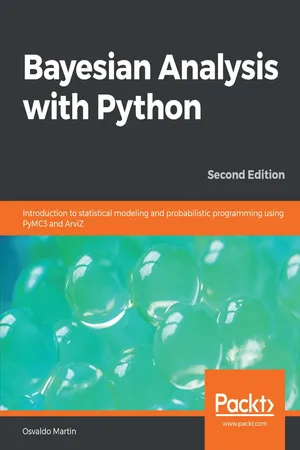
Bayesian Analysis with Python
Introduction to statistical modeling and probabilistic programming using PyMC3 and ArviZ, 2nd Edition
- 356 pages
- English
- ePUB (mobile friendly)
- Available on iOS & Android
Bayesian Analysis with Python
Introduction to statistical modeling and probabilistic programming using PyMC3 and ArviZ, 2nd Edition
About This Book
Bayesian modeling with PyMC3 and exploratory analysis of Bayesian models with ArviZ
Key Features
- A step-by-step guide to conduct Bayesian data analyses using PyMC3 and ArviZ
- A modern, practical and computational approach to Bayesian statistical modeling
- A tutorial for Bayesian analysis and best practices with the help of sample problems and practice exercises.
Book Description
The second edition of Bayesian Analysis with Python is an introduction to the main concepts of applied Bayesian inference and its practical implementation in Python using PyMC3, a state-of-the-art probabilistic programming library, and ArviZ, a new library for exploratory analysis of Bayesian models.
The main concepts of Bayesian statistics are covered using a practical and computational approach. Synthetic and real data sets are used to introduce several types of models, such as generalized linear models for regression and classification, mixture models, hierarchical models, and Gaussian processes, among others.
By the end of the book, you will have a working knowledge of probabilistic modeling and you will be able to design and implement Bayesian models for your own data science problems. After reading the book you will be better prepared to delve into more advanced material or specialized statistical modeling if you need to.
What you will learn
- Build probabilistic models using the Python library PyMC3
- Analyze probabilistic models with the help of ArviZ
- Acquire the skills required to sanity check models and modify them if necessary
- Understand the advantages and caveats of hierarchical models
- Find out how different models can be used to answer different data analysis questions
- Compare models and choose between alternative ones
- Discover how different models are unified from a probabilistic perspective
- Think probabilistically and benefit from the flexibility of the Bayesian framework
Who this book is for
If you are a student, data scientist, researcher, or a developer looking to get started with Bayesian data analysis and probabilistic programming, this book is for you. The book is introductory so no previous statistical knowledge is required, although some experience in using Python and NumPy is expected.
Frequently asked questions
Information
Modeling with Linear Regression
- Simple linear regression
- Robust linear regression
- Hierarchical linear regression
- Polynomial regression
- Multiple linear regression
- Interactions
- Variable variance
Simple linear regression










- Model the relationship between factors like rain, soil salinity, and the presence/absence of fertilizer in crop productivity. Then, answer questions such as: is the relationship linear? How strong is this relationship? Which factors have the strongest effect?
- Find a relationship between average chocolate consumption by country and the number of Nobel laureates in that country, and then understand why this relationshi...
Table of contents
- Title Page
- Copyright and Credits
- Dedication
- About Packt
- Foreword
- Contributors
- Preface
- Thinking Probabilistically
- Programming Probabilistically
- Modeling with Linear Regression
- Generalizing Linear Models
- Model Comparison
- Mixture Models
- Gaussian Processes
- Inference Engines
- Where To Go Next?
- Other Books You May Enjoy